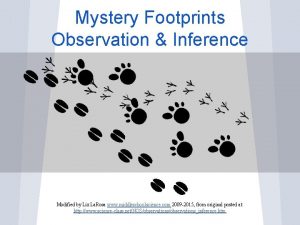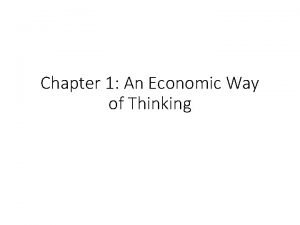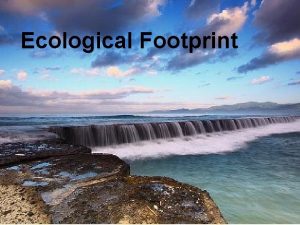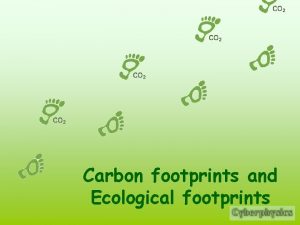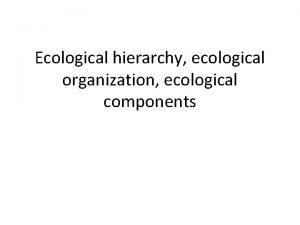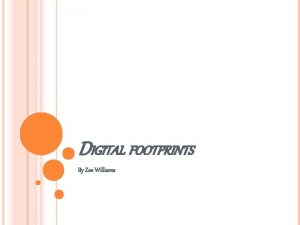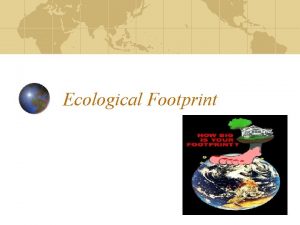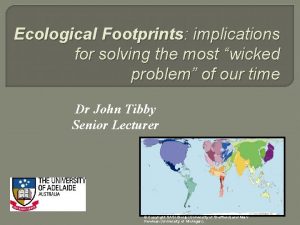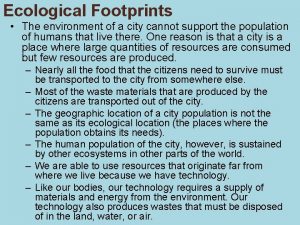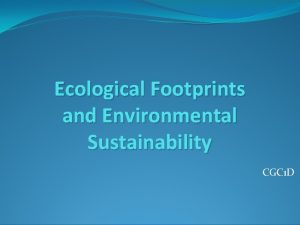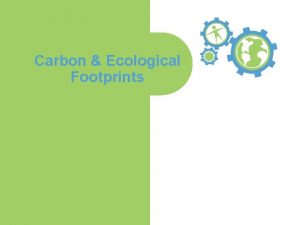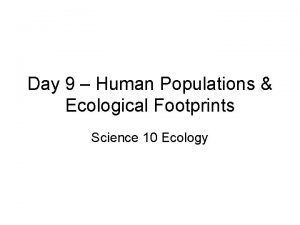Ecological Footprints a way of thinking of the






















- Slides: 22

Ecological Footprints a way of thinking of the environmental impact of individual people, organisations, communities

The Ecological Footprint is an indicator of human pressure on nature. “Earth provides enough to satisfy every man’s need but not to every man’s greed” -Mahatma Ganndhi

Ecological Footprints are a measure of human impact on the Earth. The footprint equals the Earth’s cost to sustain one person. It’s measured in hectares and represents the land area needed to provide resources and absorb waste and greenhouse gases produced by an individual.

Ecological Footprints The ecological footprints given here are based on six main categories. Arable land for cultivation of food, animal feed, fiber, oil crops, and rubber Pasture- Grazing land for producing meat, hides, wool, and milk Forest for harvesting timber, fuel wood, and wood fiber for paper Sea space – for catching fish Built-up land for accommodating infrastructure for housing, transportation, and industrial production Land to seqestation Direct CO 2 emissions from fossil fuels; indirect emissions for products manufactured abroad; gas flaring.

Ecological Footprint We require …. . • 0. 2 hectares of land for water (to drink & provide seafood) • 1. 6 hectares of land for farmland to grow the food we eat • 0. 3 hectares of land for grazing land for meat and dairy • 1. 4 hectares of land for timber wood and paper products • 4. 7 hectares of land needed to absorb the greenhouse gases produced by driving around town, through the running of air conditioners and the import of exotic goods and foods = 8. 6 hectares

The more you consume, the larger your footprint will be! Clothes Waste Water…. . Fun stuff! Food Energy! Housing

How Useful Is It? Indicator of sustainability. Conceptual simplicity. Clear indicator of progress towards sustainability. Clear indicator of resource injustice. National footprint comparisons.

Global And National Footprints The planet’s biocapacity is estimated at 1. 9 hectares person. Some countries are already using up 2. 2 hectares person. The planet’s biocapacity is under threat due to an increasing population. Ecosystems are being used up due to OUR actions (fisheries, oceans, forests, coral reefs, soil, water etc). The higher the consumption by population results in a decrease of the planets’ carrying, renewal and regeneration capacities.

How Do Countries Compare? Country Hectares United States 10. 3 Australia 9. 0 Canada 7. 8 Germany 5. 3 United Kingdom 5. 2 Switzerland 5. 1 China 1. 6 India 0. 8

How Do Countries Compare? Countries are either: a) Ecological debtors: � Larger footprints. � Changing sizes of the countries in proportion. � Could be harvesting resources unsustainably, importing goods or exporting wastes. b) Ecological creditors: � Smaller footprints than biocapacity. � Biocapacity: living capacity or natural resources.


If everyone lived like the average European we would need THREE planets to live on ….

If everyone lived like the average American we would need FIVE planets to live on ….

E F scenarios

Calculation methodology

Biocapacity and Ecological footprints

How to reduce EF



What the footprints does not measure

The Future By 2050 the planets’ biocapacity is estimated to be reduced from 1. 9 hectares person to 1. 5. In USA (the largest footprint in the world) people are estimated to be reduced to 9. 57 hectares person. If everyone lived like an average person in Bangladesh where the footprint is 0. 5 hectares person the world would be able to support 22 million people. Between 1961 and 1999, the global ecological footprint rose from 70% to 120% of the earths’ biological capacity. By the year 2050, the global ecological footprint is predicted to grow to about 180% to 220% of the Earth’s biological capacity.

Thank You
 Race determination from teeth
Race determination from teeth Take only photos leave only footprints
Take only photos leave only footprints Cai guo qiang footprints of history
Cai guo qiang footprints of history Visual management signs
Visual management signs Floor footprints visual management
Floor footprints visual management Footprints observation inference
Footprints observation inference Perbedaan critical thinking dan creative thinking
Perbedaan critical thinking dan creative thinking Positive thinking vs negative thinking examples
Positive thinking vs negative thinking examples Thinking about you thinking about me
Thinking about you thinking about me Thinking about your own thinking
Thinking about your own thinking Holistic judgement
Holistic judgement An economic way of thinking
An economic way of thinking Key layers of thinking
Key layers of thinking Scamper technique for pen
Scamper technique for pen A way of thinking
A way of thinking Walk this way talk this way
Walk this way talk this way Threaded binary tree ppt
Threaded binary tree ppt Anova two way adalah
Anova two way adalah Perbedaan one way dan two way anova
Perbedaan one way dan two way anova Principles of conventional software engineering
Principles of conventional software engineering Relative frequency two way table
Relative frequency two way table 2 way anova example
2 way anova example Bottle of rum to fill my tum
Bottle of rum to fill my tum





